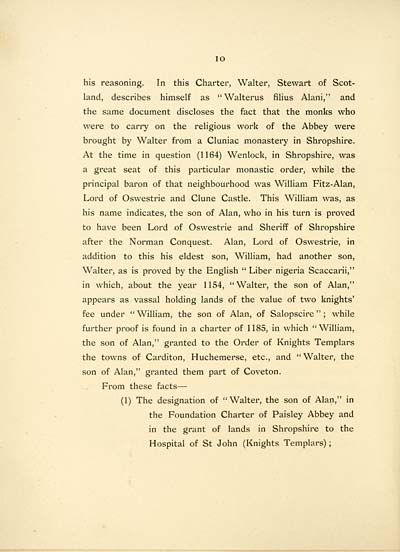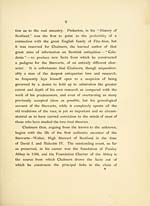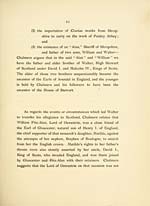Story of the Stewarts
(26) Page 10
Download files
Complete book:
Individual page:
Thumbnail gallery: Grid view | List view

IO
his reasoning. In this Charter, Walter, Stewart of Scot-
land, describes himself as "Walterus filius Alani," and
the same document discloses the fact that the monks who
were to carry on the religious work of the Abbey were
brought by Walter from a Cluniac monastery in Shropshire.
At the time in question (1164) Wenlock, in Shropshire, was
a great seat of this particular monastic order, while the
principal baron of that neighbourhood was William Fitz-Alan,
Lord of Oswestrie and Clune Castle. This William was, as
his name indicates, the son of Alan, who in his turn is proved
to have been Lord of Oswestrie and Sheriff of Shropshire
after the Norman Conquest. Alan, Lord of Oswestrie, in
addition to this his eldest son, William, had another son,
Walter, as is proved by the English " Liber nigeria Scaccarii,"
in which, about the year 1154, "Walter, the son of Alan,"
appears as vassal holding lands of the value of two knights'
fee under "William, the son of Alan, of Salopscire " ; while
further proof is found in a charter of 1185, in which "William,
the son of Alan," granted to the Order of Knights Templars
the towns of Carditon, Huchemerse, etc., and "Walter, the
son of Alan," granted them part of Coveton.
From these facts —
(1) The designation of "Walter, the son of Alan," in
the Foundation Charter of Paisley Abbey and
in the grant of lands in Shropshire to the
Hospital of St John (Knights Templars) ;
his reasoning. In this Charter, Walter, Stewart of Scot-
land, describes himself as "Walterus filius Alani," and
the same document discloses the fact that the monks who
were to carry on the religious work of the Abbey were
brought by Walter from a Cluniac monastery in Shropshire.
At the time in question (1164) Wenlock, in Shropshire, was
a great seat of this particular monastic order, while the
principal baron of that neighbourhood was William Fitz-Alan,
Lord of Oswestrie and Clune Castle. This William was, as
his name indicates, the son of Alan, who in his turn is proved
to have been Lord of Oswestrie and Sheriff of Shropshire
after the Norman Conquest. Alan, Lord of Oswestrie, in
addition to this his eldest son, William, had another son,
Walter, as is proved by the English " Liber nigeria Scaccarii,"
in which, about the year 1154, "Walter, the son of Alan,"
appears as vassal holding lands of the value of two knights'
fee under "William, the son of Alan, of Salopscire " ; while
further proof is found in a charter of 1185, in which "William,
the son of Alan," granted to the Order of Knights Templars
the towns of Carditon, Huchemerse, etc., and "Walter, the
son of Alan," granted them part of Coveton.
From these facts —
(1) The designation of "Walter, the son of Alan," in
the Foundation Charter of Paisley Abbey and
in the grant of lands in Shropshire to the
Hospital of St John (Knights Templars) ;
Set display mode to:
![]() Universal Viewer |
Universal Viewer | ![]() Mirador |
Large image | Transcription
Mirador |
Large image | Transcription
Images and transcriptions on this page, including medium image downloads, may be used under the Creative Commons Attribution 4.0 International Licence unless otherwise stated. ![]()
| Histories of Scottish families > Story of the Stewarts > (26) Page 10 |
|---|
| Permanent URL | https://digital.nls.uk/95230547 |
|---|
| Description | A selection of almost 400 printed items relating to the history of Scottish families, mostly dating from the 19th and early 20th centuries. Includes memoirs, genealogies and clan histories, with a few produced by emigrant families. The earliest family history goes back to AD 916. |
|---|

